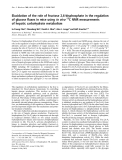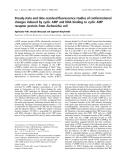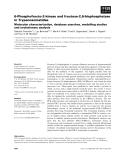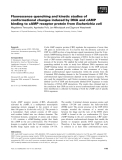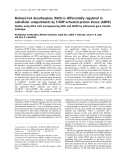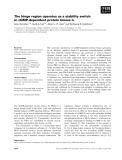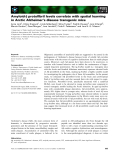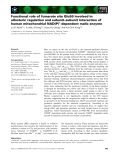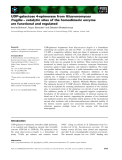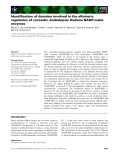
Allosteric regulation
-
A reaction happens need the energy to vibrate the molecules and the reactant concentration enough. The energy here is often provided by heat. However, in living system, high temperature may harm the biological structure Truly that the concentration in living system is very low. So living organisms solve these problems by using enzyme
 94p
94p  zingzing09
zingzing09
 21-10-2012
21-10-2012
 68
68
 10
10
 Download
Download
-
Fructose 2,6-bisphosphate (Fru-2,6-P2 ) plays an important role in the regulation of major carbohydrate fluxes as both allosteric activator and inhibitor of target enzymes. To examine the role of Fru-2,6-P2in the regulation of hepatic carbohydrate metabolism in vivo,Fru-2,6-P2 levels were elevated in ADM mice with adenovirus-mediated overex-pression of a double mutant bifunctional enzyme, 6-phos-phofructo-2-kinase/fructose-2,6-bisphosphatase (n¼6), in comparison to normal control mice (control,n¼6). ...
 9p
9p  research12
research12
 29-04-2013
29-04-2013
 51
51
 5
5
 Download
Download
-
Escherichia coli 3-phosphoglycerate dehydrogenase (PGDH) catalyzes the first step in serine biosynthesis, and is allosterically inhibitedby serine. Structural studies revealeda homotetramer in which the quaternary arrangement of subunits formed an elongated ellipsoid. Each subunit consisted of three domains: nucleotide, substrate and regu-latory. InPGDH, extensive interactions are formedbetween nucleotide binding domains.
 9p
9p  research12
research12
 23-04-2013
23-04-2013
 38
38
 2
2
 Download
Download
-
cAMP receptor protein (CRP), allosterically activated by cAMP, regulates the expression of several genes inEscheri-chia coli. As binding of cAMP leads to undefined conform-ational changes in CRP, we performed a steady-state and time-resolved fluorescence study to showhow the binding of the ligand influences the structure and dynamics of the protein. We used CRP mutants containing a single trypto-phan residue at position 85 or 13, and fluorescently labeled with 1,5-I-AEDANS attached toCys178.
 11p
11p  tumor12
tumor12
 20-04-2013
20-04-2013
 33
33
 3
3
 Download
Download
-
Fructose 2,6-bisphosphate is a potent allosteric activator of trypanosomatid pyruvate kinase and thus represents an important regulator of energy meta-bolism in these protozoan parasites. A 6-phosphofructo-2-kinase, respon-sible for the synthesis of this regulator, was highly purified from the bloodstream form ofTrypanosoma bruceiand kinetically characterized. By searching trypanosomatid genome databases, four genes encoding proteins homologous to the mammalian bifunctional enzyme 6-phosphofructo-2-kinase⁄fructose-2,6-bisphosphatase (PFK-2⁄FBPase-2) were found for both T. ...
 19p
19p  fptmusic
fptmusic
 11-04-2013
11-04-2013
 34
34
 3
3
 Download
Download
-
Cyclic AMP receptor protein (CRP) regulates the expression of more then 100 genes inEscherichia coli. It is known that the allosteric activation of CRP by cAMP involves a long-distance signal transmission from the N-ter-minal cAMP-binding domain to the C-terminal domain of CRP responsible for the interactions with specific sequences of DNA. In this report we have used a CRP mutant containing a single Trp13 located in the N-terminal domain of the protein.
 14p
14p  awards
awards
 05-04-2013
05-04-2013
 45
45
 4
4
 Download
Download
-
Malonyl-CoA, a potent inhibitor of carnitine pamitoyl transferase-I (CPT-I), plays a pivotal role in fuel selection in cardiac muscle. Malonyl-CoA decarboxylase (MCD) cata-lyzes the degradation of malonyl-CoA, removes a potent allosteric inhibition on CPT-I and thereby increases fatty acid oxidation in the heart. Although MCDhas several Ser/ Thr phosphorylation sites, whether it is regulated by AMP-activated protein kinase (AMPK) has been controversial. We therefore overexpressed MCD(Ad.MCD) and consti-tutively active AMPK (Ad.
 10p
10p  dell39
dell39
 03-04-2013
03-04-2013
 39
39
 3
3
 Download
Download
-
The molecular mechanism of cGMP-dependent protein kinase activation by its allosteric regulator cyclic-3¢,5¢-guanosine monophosphate (cGMP) has been intensely studied. However, the structural as well as thermo-dynamic changes upon binding of cGMP to type I cGMP-dependent protein kinase are not fully understood.
 13p
13p  galaxyss3
galaxyss3
 19-03-2013
19-03-2013
 37
37
 4
4
 Download
Download
-
Here we report on the role of Glu59 in the fumarate-mediated allosteric regulation of the human mitochondrial NAD(P) + -dependent malic enzyme (m-NAD-ME). In the present study, Glu59 was substituted by Asp, Gln or Leu. Our kinetic data strongly indicated that the charge properties of this residue significantly affect the allosteric activation of the enzyme.
 12p
12p  vinaphone15
vinaphone15
 27-02-2013
27-02-2013
 31
31
 2
2
 Download
Download
-
The two main mammalian calpains, 1 and 2, are heterodimers of a large 80 kDa and a small 28 kDa subunit that together bind multiple calcium ions during enzyme activation. The main contact between the two subunits of these intracellular cysteine proteases is through a pairing of the fifth EF-hand of their C-terminal penta-EF-hand (PEF) domains.
 12p
12p  vinaphone15
vinaphone15
 27-02-2013
27-02-2013
 34
34
 3
3
 Download
Download
-
UDP-galactose 4-epimerase fromKluyveromyces fragilisis a homodimer containing one catalytic site and one NAD + as cofactor per subunit. One 5¢-UMP, a competitive inhibitor, binds per dimer of epimerase as isolated and causes inactivation. Addition of 0.2 mminhibitor to the enzyme in vitro leads to three sequential steps: first, the inhibitor binds to the unoccupied site; second, the inhibitor bound ex vivo is displaced allosterically; and finally, both sites are occupied by the inhibitor.
 16p
16p  viettel02
viettel02
 20-02-2013
20-02-2013
 36
36
 3
3
 Download
Download
-
TheArabidopsis thalianagenome contains four genes encoding NADP-malic enzymes (NADP-ME1–4). Two isoenzymes, NADP-ME2 and NADP-ME3, which are shown to be located in the cytosol, share a remarkably high degree of identity (90%). However, they display different expression patterns and show distinct kinetic properties, especially with regard to their regulation by effectors, in both the forward (malate oxida-tive decarboxylation) and reverse (pyruvate reductive carboxylation) reac-tions.
 13p
13p  viettel02
viettel02
 20-02-2013
20-02-2013
 30
30
 2
2
 Download
Download
CHỦ ĐỀ BẠN MUỐN TÌM









